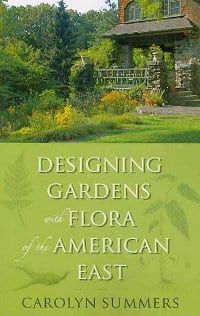Designing Gardens with Flora of the American East (Rutgers University Press, 2010) is written by Carolyn Summers. Summers will be presenting “The Practical Challenges of Designing with Native Plants” at ELA’s Conference & Eco-Marketplace on March 3.
reviewed by Risa Edelstein
 If you’ve read Doug Tallamy’s book, Bringing Nature Home and were hungry for more, Carolyn Summers’ Designing Gardens with Flora of the American East (Rutgers University Press, 2010) is a great follow up. Chock full of interesting facts and figures, Summers approaches design through the lens of ecology making the book unique in its approach and very relevant to anyone creating native gardens for a living.
If you’ve read Doug Tallamy’s book, Bringing Nature Home and were hungry for more, Carolyn Summers’ Designing Gardens with Flora of the American East (Rutgers University Press, 2010) is a great follow up. Chock full of interesting facts and figures, Summers approaches design through the lens of ecology making the book unique in its approach and very relevant to anyone creating native gardens for a living.
Summers weaves scientific information throughout the book beginning in the first chapter with a discussion of current research suggesting that an indigenous landscape will host the greatest number of birds. She identifies which berries are most nutritious for birds and includes their fat content. (Myrica pensylvanica is highest on her list at 50.3%.) In another example, she discussed how white flowers attract night-flying moths (Pycnanthemum spp.).
The book is region specific, focusing on the Northeast which makes it extremely relevant and practical if you work or garden in that area of the country. What I enjoyed most about this book was that it offered up a lot of new information and was not a repeat of what I had read somewhere else.
Practice Makes Perfect
Summers often points out that our landscape practices have a significant impact on the ecology and that we need to consider that impact in our designs and our approach to maintenance. For example, she makes the case to stop removing leaf litter by providing concrete examples including the fact that the cocoons of the Luna moth fall from their host plants and need to spend the winter in leaf litter. Similarly, the leaf litter we continue to bag and export to be composted may also contain butterfly chrysalides which may explain why we have so few butterflies each season.
Designing with Nature
Summers devotes two chapters to design. One chapter focuses on creating traditional gardens such as perennial borders, foundation planting, hedges, and cottage gardens that incorporate native plants. In a second chapter, Summers discusses landscape design by referencing indigenous plant communities such as woodland garden, the forest edge and meadows – all of which I have seen referenced before. However, as in the rest of the book, she takes the discussion one step further and talks about Fern Glades, Blueberry Heaths, and Old Fields as well.
Alternatives to Invasives
A whole chapter of Designing Gardens is devoted to identifying alternatives to invasive plants. Summers actually begins her book with a note that no garden is an island and that we need to take the broader ecological effects into account. She makes a strong point by referencing Frederick Law Olmstead who designed NYC Central Park with Norway Maples, never guessing that they would invade nearby forests.
Throughout the book, the plant lists are extensive and Summers often refers to some of the newest cultivars in her descriptions. I tried desperately to locate a ‘Canada Red’ chokeberry when I finished reading this book, but it was impossible to find. My hope is that with the growing interest in ecology and native plant design, more nurseries will broaden their plant selections and offer some of the cultivars she mentions.
It’s refreshing to read a book by someone who understands landscape design and is an apparent plant enthusiast but who also sees her designs through an ecological lens. It’s rather rare to find someone that looks at gardens this way. I highly recommend the book for any designer interested in better understanding the ecological impact of his work.
About the Author
 Risa Edelstein trained as an ecological landscape designer at the Landscape Institute of the Arnold Arboretum of Harvard University. She is a member of the Association of Professional Landscape Designers, accredited with NOFA as an organic landcare professional, and the current President of the Ecological Landscape Alliance. Risa may be contacted at www.risaedelstein.com or www.linkedin.com/myprofile?trk=hb_tab_pro.
Risa Edelstein trained as an ecological landscape designer at the Landscape Institute of the Arnold Arboretum of Harvard University. She is a member of the Association of Professional Landscape Designers, accredited with NOFA as an organic landcare professional, and the current President of the Ecological Landscape Alliance. Risa may be contacted at www.risaedelstein.com or www.linkedin.com/myprofile?trk=hb_tab_pro.

